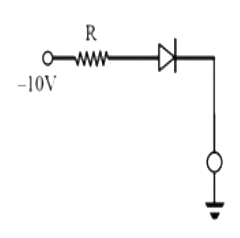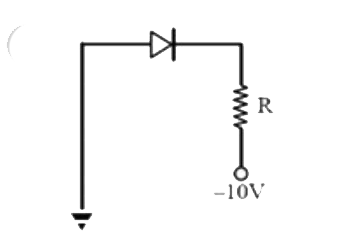In a p−n junction diode, the currect I can expressed as I=I0exp(eV2kBT−1) where I0 is called the reverse saturation current, V is the voltage across the diode and is positive for forward bias and negative for reverse bias, and I is the current through the diode, KB is the Boltzmann constant (8.6×10−5eV/K) and T is the absolute temperature. If for a given diode Io=5×10−12A and T=300K, then
(a) What will be the forward current at a formward voltage of 0.6V ?
(b) What will be the increase in the current if the voltage across the diode is increased to 0.7V ?
( c) What is the dynamic resistance ?
(d) What will be current if reverse bias voltage changes from 1V to 2V ?
Here, I0=5×10−12A,T=300K,kB=8.6×10−5eVK−1=8.6×10−5×1.6×10−19JK−1
If V=0.6V, theneVkT=1.6×10−19×0.68.6×10−5×1.6×10−19×300=23.26
I=I0[exp(eVkT−1)]=5×10−12[e23.26−1]=5×10−12[1.259×1010−1]
=5×10−12×1.259×1010=0.063A
If V=0.7V,theneVkT=1.6×10−19×0.78.6×10−5×1.6×10−19×300=27.14
I=I0[exp(eVkT−1)]=5×10−12[e27.14−1]=5×10−12[6.07×1011−1]
=5×10−12×6.07×1011=3.035A
:. Increase in current, ΔI=(3.035−0.063)=2.972A
Since, ΔI=2.972A,ΔV=0.7−0.6=0.1V Dynamic resistance=ΔVΔI=0.1V2.972A=0.0336Ω
As the voltage changes from 1 to 2 V, the current I will be almost equal to I0(=5×10−12A), showing that the diode possesses practially infinite dynamic resistance in the reverse bias.
Topper's Solved these Questions
- ELECTRONIC DEVICESBook:PRADEEPChapter:ELECTRONIC DEVICESExercise:ADVANCED PROBLEMS FOR COMPETITIONS
Explore 2 Videos
- ELECTRONIC DEVICESBook:PRADEEPChapter:ELECTRONIC DEVICESExercise:VERY SHORT QUESTION ANSWER (NCERT)
Explore 1 Video
- ELECTRONIC DEVICESBook:PRADEEPChapter:ELECTRONIC DEVICESExercise:SHORT QUESTION ANSWER
Explore 1 Video
- ELECTROMAGNETIC WAVESBook:PRADEEPChapter:ELECTROMAGNETIC WAVESExercise:II Focus multiple choice question
Explore 5 Videos
- ELECTROSTATICSBook:PRADEEPChapter:ELECTROSTATICSExercise:ASSERTION-REASON TYPE QUESTIONS
Explore 2 Videos
Similar Questions
In a p−n junction diode, the currect I can expressed as I=I0exp(eV2kBT−1) where I0 is called the reverse saturation current, V is the voltage across the diode and is positive for forward bias and negative for reverse bias, and I is the current through the diode, KB is the Boltzmann constant (8.6×10−5eV/K) and T is the absolute temperature. If for a given diode Io=5×10−12A and T=300K, then
(a) What will be the forward current at a formward voltage of 0.6V ?
(b) What will be the increase in the current if the voltage across the diode is increased to 0.7V ?
( c) What is the dynamic resistance ?
(d) What will be current if reverse bias voltage changes from 1V to 2V ?
View SolutionIn a p−n junction diode, the currect I can expressed as I=I0exp(eV2kBT−1) where I0 is called the reverse saturation current, V is the voltage across the diode and is positive for forward bias and negative for reverse bias, and I is the current through the diode, KB is the Boltzmann constant (8.6×10−5eV/K) and T is the absolute temperature. If for a given diode Io=5×10−12A and T=300K, then
(a) What will be the forward current at a formward voltage of 0.6V ?
(b) What will be the increase in the current if the voltage across the diode is increased to 0.7V ?
( c) What is the dynamic resistance ?
(d) What will be current if reverse bias voltage changes from 1V to 2V ?
View Solution
Knowledge Check
When a p-n junction diode is reverse biased
AFlow of a minority charge carrier from p - side of n - sideBFlow of a majority charge carrier from n - side to p - sideCFlow of a majority charge carrier from p - side to n - sideDFlow to electrons from n - side to p - sidePassage II
Diode current in a p-n junction diode is given by I−I0[exp(eV)2kT−1] where I0 is the reverse saturation current V is the voltage across the diode k is the boltzmann constant and T is the abosolute temperatuer For a given diode I0=5 pA and T =300 k
The forward current at a foward voltage V=0.6 V isA0.05475 AB0.06319 AC0.04482 AD0.03798 AIn the figure, which of the diode is in reverse bias
A B
B C
C D
D
Draw the graph showing the variation of current with voltage for a p-n junctin diode when the diode is (i) forward biased and (ii) reyerse biased
View SolutionIs reverse saturation current of a diode independent of reverse bias voltage?
View SolutionWhen the voltage drop across a p.n junction diode is increased from 0.65V to 0.70V, the change in the diode current is 5mA. What is the dynamic resistance of the diode?
View SolutionDraw the V-I characterisitics of p-n junction diode in forward bias and in reverse bias.
View SolutionIn a p-n junction diode the reverse saturation current is 10μA. What will be the forward current for a voltager of 0.2 V ?
View Solution

